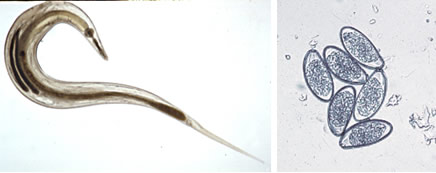Etiology: Passalurus ambiguus is a nematode in the family Oxyuridae.
Incidence: The incidence of infection is uncommon in research animals.
Transmission: Transmission occurs via ingestion of infective ova. Females release their eggs while in the cecum, so that eggs are infective immediately as they are passed. The prepatent period is 15 – 26 days.
Distribution: Adult worms reside in the cecum and large intestine [1]. Immature stages may be found in the small intestine.
Clinical Signs: The rabbit pinworm does not cause clinical disease in infected rabbits, even with heavy worm burdens.
Diagnosis:
Antemortem: Fecal flotation for ova has low sensitivity and negatives should regarded cautiously Cellophane tape tests provide a more sensitive result. Tests should be performed during the afternoon and evening due to circadian rhythm of egg excretion [2].
Postmortem: Examination of cecal contents for adult forms.
Diagnostic Morphology: P. ambiguus adults have a round esophageal bulb.
Female: 9 – 11 mm long, with a long, finely-pointed tail.
Male: 4 – 5 mm long, with a finely-pointed tail. Ventral mammelons are difficult to identify.
Ova: 93 – 103 x 45 µm. Thin-shelled and football shaped with a slightly flattened side.

1. The Laboratory Rabbit, Guinea Pig, Hamster, And Other Rodents. 1 ed2012, 225 Wyman Street, Waltham, MA 02451: Elsevier.
2. Rinaldi, L., et al., Passalurus ambiguus: new insights into copromicroscopic diagnosis and circadian rhythm of egg excretion. Parasitol Res, 2007. 101(3): p. 557-61.